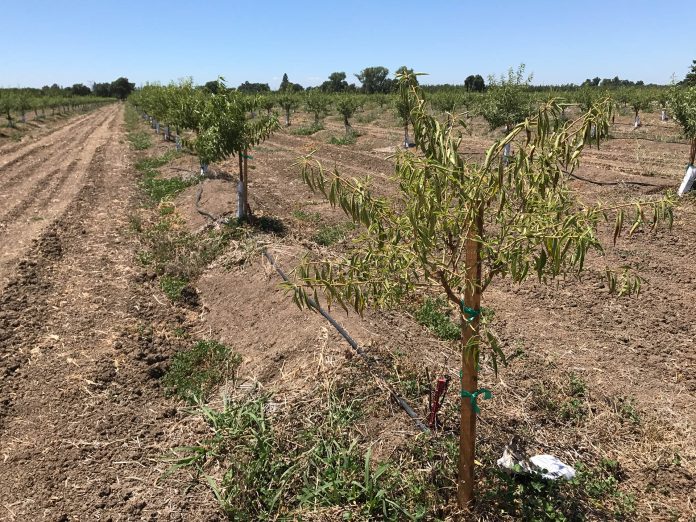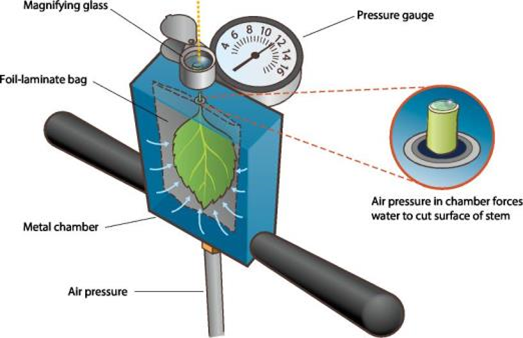
One of the motivations for making good water management decisions early in the growing season is to reduce the risk of root and crown diseases that can eventually kill almond and other tree species. These diseases need three elements to infect and damage a tree: a susceptible host plant, a pathogen, and favorable environmental conditions.
A second motivation for diligent early season water management is that even in the absence of a pathogen like Phytophthora, root death due to waterlogging alone can damage or kill trees. Prolonged wet early season conditions have been linked to the “yellowing Krymsk” and “yellowing Rootpac-R” problem in young orchards. This problem which is most often associated with the ‘Monterey’ variety, often resolves itself with careful soil moisture monitoring. Similarly, in older orchards, over-watered conditions in March through May have been linked to the lower limb dieback (LLD) problem. Both conditions show that early season water management can greatly impact tree health much later in the season.

You can read more about “yellowing Krymsk” at: sacvalleyorchards.com/almonds/foliar-diseases/yellowing-krymsk/ and about LLD at: thealmonddoctor.com/2014/05/16/lower-limb-dieback-almond/
Early season water management influences the environment where roots grow by affecting soil temperature and aeration and can be pivotal in how much tree decline occurs. Trees are expensive. The money and effort spent to establish them is lost, more costs lie ahead to replace them, and production is lost.
Choosing the Best Time to Start Irrigating
Each season you need to decide when to start irrigating. It can be difficult to choose the best time to start irrigation. There are a lot of different information sources you can use to make this decision. You can copy practices that you observe around you, evaluate soil moisture, consider the weather and evapotranspiration loss of the crop (ETc), or take a plant-based approach. Utilizing multiple information sources is highly recommended. However, utilizing the plant-based monitoring approach of stem water potential readings with a pressure chamber (or “pressure bomb”) has a distinct advantage over the others.

The pressure chamber directly determines the water status experienced by the trees, while the other sources, such as ET or soil moisture, although helpful, are indirect. The pressure chamber gauges the amount of positive gas pressure (in pressure units, e.g. bars) required to balance the level of water tension in a plant sample (e.g. leaf; see related graphic). The level of water tension in a leaf expresses the degree of effort utilized to pull water all the way through the tree from the soil.
Relying on an indirect information source, particularly an approach like beginning irrigation when your neighbor does, when the surface soil has dried out, or irrigating on the first hot day, could result in irrigating too soon.
Using Information to Delay the First Irrigation
Research in walnut orchards in California’s Tehama and Stanislaus counties has found that the start of irrigation can be delayed by waiting for mild to moderate water status when measured with the pressure chamber. Some observed benefits have been a minimum 10-percent reduction in energy for pumping, less tree stress during harvest season, and no impact on edible kernel yield. A managed (informed) delay in the start of irrigation may allow for deeper root activity late in the season. It’s possible that a strategy that starts the irrigation season too early promotes a shallow root system at the expense of deeper root development. This is completely contradictory to the conventional wisdom in walnut and almond production that early season irrigation allows for “banking of water” to help avoid high water stress at harvest. UC researchers plan to investigate this managed irrigation delay in almonds in the northern Sacramento Valley.
Before UC researchers begin to see results from this work in almonds, it is best to be cautious in choosing a level of stem water potential with the pressure chamber to trigger the first irrigation of the season. From everything we currently understand, waiting for a tree water status of -2 bars below the fully watered baseline before applying the first irrigation represents a low risk irrigation decision that could benefit long term tree and root health. To learn more about the pressure chamber, stem water potential, the fully watered baseline, and how to go about getting equipment and taking measurements, check out our series at: sacvalleyorchards.com/manuals/stem-water-potential/
Monitoring Weather—Crop Evapotranspiration (ETc)
If using the pressure chamber isn’t appealing, or a second source of information is desired, monitoring the weather and evapotranspiration crop losses is an option. This method is sometimes called a “water budget,” because it is analogous to budgeting money. Soil water storage in the crop root zone equates to a balance in a checking or savings account. ET equates to a debit from the account and significant rainfall or irrigation equates to a deposit or credit into the account. Water budgeting approximates the soil moisture level in the root zone rather than measuring it with soil moisture sensors.
Weekly ET reports are available during the irrigation season online or can be delivered weekly by email. ET is estimated based upon real-time weather measurements at regional CIMIS weather stations. Estimates are for trees with at least 50 percent canopy cover and need to be adjusted downward for smaller trees. Each report provides a real-time estimate of ET in inches for the past seven days, an estimate for the next seven days, and keeps a running total for the season. Accumulations begin at leaf-out for each crop which enables their use to help decide when to begin the irrigation season. It is important to know the hourly water application rate (inches/hour) of your irrigation system.
Using an example from the 2018 season, if we followed each weekly report from February 16 to May 3 for the Gerber South CIMIS weather station, it showed that cumulative ET for almonds was 7.51 inches while cumulative rainfall for the same period was 5.26 inches and resulted in a 2.25-inch soil moisture deficit. This assumed that all of the rainfall was effectively used in the orchard which is a site-specific consideration that needs to be adjusted accordingly in the water budget. Dividing this 2.25-inch soil moisture deficit by a water application rate of 0.07 inch per hour (i.e. an almond orchard with 124 trees per acre with one 16 gph microsprinkler per tree) equates to 32 hours of irrigation or the equivalent of two 16-hour irrigation sets that suit PG&E off-peak rates. Choice of set length is site-specific depending on irrigation system and soil type; however, it is best to minimize ponding conditions that can starve roots of oxygen and provide favorable disease conditions.
For help with your own ET calculations see: sacvalleyorchards.com/et-reports/
The previous example provides context on how this deficit relates to the irrigation system capacity. It is left to the irrigation manager’s judgement to continue to delay the beginning of irrigation to protect tree and root health, begin irrigation by partially refilling the soil moisture deficit (i.e. one 16-hour irrigation set), or begin irrigation and fully replace the soil moisture deficit. If this information were paired with the pressure chamber measurements and the stem water potential measurements were still within -2 bars of the fully irrigated baseline, the manager may have more peace of mind about continuing to delay the first irrigation.
Monitoring Soil Moisture Depletion
If neither the pressure chamber nor water budgeting appeal to you or you are looking for a supplement to one or both methods, directly monitoring soil moisture is an option. Checking soil moisture by hand is a very basic method to evaluate soil moisture conditions. There are many online stores where soil augers can be purchased (examples include: JMC Backsaver, AMS samplers, Forestry Suppliers, and Ben Meadows). For interpretation of soil moisture in collected samples, the USDA-National Resource Conservation Service also offers a nicely prepared publication with color pictures titled Estimate Soil Moisture by Feel and Appearance.
There are also a wide variety of soil moisture sensors that can also be used. Refer to the UC ANR article Soil Moisture Sensor Selection is Confusing for more insight: sacvalleyorchards.com/blog/soil-moisture-sensor-selection-is-confusing/
The Judgment of the Irrigation Manager
Stem water potential readings with a pressure chamber, evapotranspiration-based water budgets and soil moisture monitoring all bring different and valuable information to the decision of when to first irrigate almonds. Stem water potential readings with the pressure chamber offer the most direct measure of tree irrigation need. In addition, adopting this practice may both save water and encourage valuable deep root development. No matter if you choose to adopt one, or all three of these monitoring approaches, the irrigation-manager’s careful judgement is most important.
















